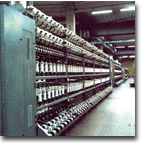 T
T
he Fillattice Group (Fillattice SpA, Italy, and Fillattice Inc., Charlotte., N.C.) is a
dynamic Italian industrial corporation that has become one of the most important producers of
elastomeric fibers, stretch fabrics, covered yarns and textile machinery.
In the aftermath of World War II, the company branched into the production of rubber yarns
derived from latex and became one of the world leaders in this field.
In the ’70s Fillattice Group launched Linel®, a polyurethane-based elastic fiber. The success
prompted the establishment of the Lineltex plant to produce stretch fabrics.
An international network of production and distribution facilities was installed as well. The
demand for Linel in the textile sector, and the development of new applications, have driven the
Fillattice Group to increase its production capacity steadily in the past years.
(See “Fillattice Boosts Spandex Image Worldwide”
ATI
, February 2000.)
The Wet-Process Yarn
Linel is a continuous polyurethane
fiber composed of filaments. It has a high elasticity and remarkable strength of recovery without
being constrictive. It is produced through a wet-processing technology that provides the yarn with
the advantage of leaving it with the highest elongation.
Linel is recognized on the world market as being one of the best elastomeric fibers due to
its technical characteristics and high quality levels.
Linel’s high stretch, remarkable softness and silky hand allow the production of fabrics
with exceptional qualities of comfort and stretch, wearability, softness and adherence.
Typical applications for Linel are outerwear, sportswear, swim-wear, underwear, hosiery,
medical and industrial articles, furnishings and many other applications.
Linel is available in a broad range of counts, from 11 dtex to 1,880 dtex on spools and on
beams. Linel is produced in a “semi-clear” version in a count ranging from 44 to 1,880 dtex. It is
also produced in a “semi-dull” version to avoid appearance problems of too high luster in certain
garments.
The production of this fiber is carried out at the Fillattice 2 and FIES production plants
through “wet-spun” technology that enables Linel to have some technical characteristics that are
unique amongst the world’s best elastams.
Linel has a high elongation of up to seven times its original length, and due to its great
recovery, it returns to its original length as soon as the tension is released.
Linel distinguishes itself from other elastams due to its exceptional regularity which
enables the creation of extremely fine, even fabrics. Because of this fact some of the most
recognized garment manufacturers in the world choose fabrics with Linel, especially in the swimwear
and sportswear field.
The Dry-Process Yarn
Linel Comfort® yarn is produced from
fiber manufactured at the new Fillattice 3 plant. The fiber itself was created by Fillattice’s
in-house research and development team and uses the innovative “dry-spun” technology.
Fillattice claims that Linel Comfort has, in addition to the standard properties of other
elastams, exceptionally well controlled and pleasant compression, good adherence and comfortable
wearability. It is for these reasons that Linel Comfort is used predominantly in ladies hosiery and
woven materials.
Linel Comfort is produced in a clear and dull version from 11 dtex to 235 dtex.
Applications And End-Uses
Linel in its original condition, “
bare Linel,” as Fillattice calls it, can be used on circular knitting machines or weaving machines
equipped with positive feeders that control the tension of the elastam, help the unwinding of the
yarn from the package and ensure constant conditions for the yarn.
The main uses of bare Linel are in circular knitting for casual wear and underwear; in warp
knitting fabrics for swimwear, sportswear, underwear, corsetry, narrow fabrics and stretch laces;
and finally, the application in ladies hosiery.
Covered Linel is used in applications where bare Linel cannot be used. It enhances the
processability by increasing friction resistance. Furthermore, it permits more control over the
maximum elasticity of the fiber, allowing a very controlled feeding of the yarn on the knitting
machine.
Covered Linel can achieve very prestigious looks in fabrics. Single- or double-covered yarns
are mainly used for high-quality tights, narrow fabrics, woven fabrics like denim and gabardine,
and circular and flat knit goods.
In intermingled yarns, a multi-filament continuous yarn covers Linel. Through an air-jet
process, intermingling the cover fibers in a random manner creates a non-uniform cover of Linel.
This yarn is used in the circular and flat knitting, woven fabrics, and men’s hosiery and sports
socks.
Other versions of covered yarns are core-spun yarns that are used in fabrics of particular
high quality, and twisted yarns, where Linel is twisted together with other yarns.
Linel and Linel Comfort are always used with other natural or synthetic fibers in order to
give the final product elasticity and comfort. The percentage of Linel in the final product depends
on the demanded characteristics of the product.
For example, between 2 percent and 4 percent are usually used in a woven fabric, 20 percent
are used in warp-knitted fabrics, and up to 25 to 30 percent are used in ladies hosiery.
Some technical fabrics up to 35- to 40-percent Linel and Linel Comfort may be used.
Great Outlook
As already mentioned, Fillattice has been steadily increasing its production quantity. The
strongest markets for Linel and Linel Comfort are Europe, the United States and the NAFTA
countries, South America and the Southeast Asia.
Fillattice has made a worldwide commitment to serve its customers with the best possible
yarns, tailored to their needs. The company understands that this is a consumer driven market and
develops its products to fulfill the demands of comfort, durability, and easy care.
Fillattice’s elastic fibers are offered in a broad range of yarn counts and fashionable
colors.
March 2000




